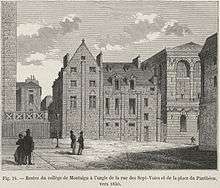Collège de Montaigu

The Collège de Montaigu was one of the constituent colleges of the Faculty of Arts of the University of Paris.
History
The college, originally called Collège des Aicelins, was founded in 1314 by Gilles I Aycelin de Montaigu, Archbishop of Narbonne and Archbishop of Rouen.[1] It changed its name after it had been restored in 1388 by his relative Pierre Aycelin de Montaigut, Bishop of Nevers and Laon.[2]
In 1483 Jan Standonck became Master of the College and made it prosper. Under the his leadership and that of his disciple Noël Béda, Montaigu was one of the leading theological colleges of Paris. Students at the college included Erasmus of Rotterdam, John Calvin, and Ignatius of Loyola (before moving to Collège de Sainte-Barbe). Other notable students were the influential Portuguese teacher and diplomat Diogo de Gouveia, philosopher John Mair (who went on to teach theology there) and the Scottish Reformer John Knox.
In his Colloquies Erasmus left a memoire of his time at the College under Standonck. Erasmus was a privileged paying student, but his memories were not pleasant.
References
| Wikimedia Commons has media related to Collège de Montaigu. |
- ↑ E F Robertson, J J O'Connor. "John Maior". School of Mathematics and Statistics - University of St Andrews, Scotland. Retrieved 3 December 2011.
- ↑ Erasmus, Desiderius (1997). Colloquies: Collected Works of Erasmus 39-40. University of Toronto Press. p. 755. ISBN 0-8020-5819-1.
Coordinates: 48°50′49″N 2°20′47″E / 48.84694°N 2.34639°E
